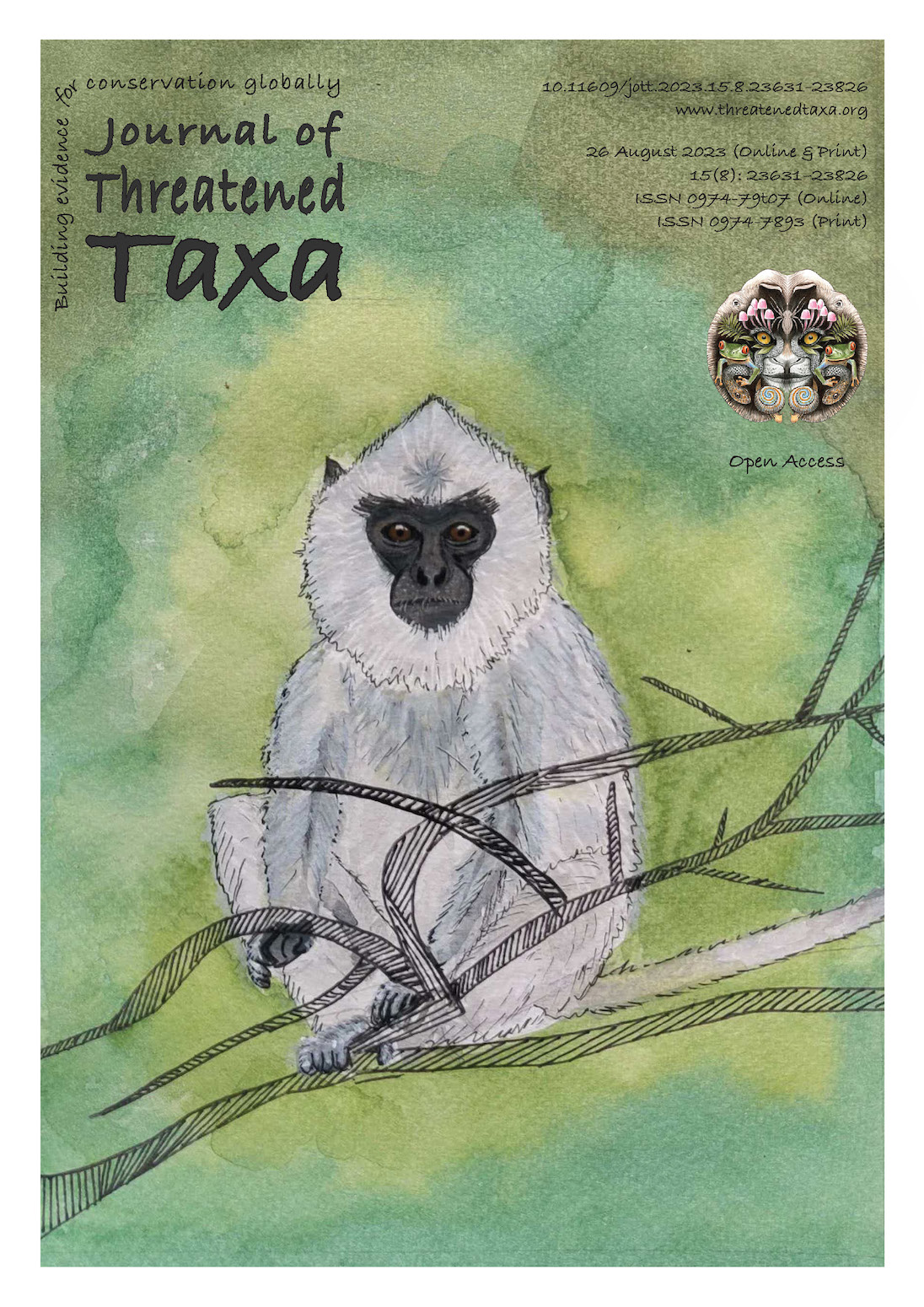Notes on nesting behavior of Yellow-footed Green Pigeon Treron phoenicopterus (Latham, 1790) in Aligarh Muslim University campus and its surroundings, Uttar Pradesh, India
Main Article Content
Abstract
The nesting behavior of the Yellow-footed Green Pigeon Treron phoenicopterus was observed during its breeding season in 2021 in an urban region encompassing the Aligarh Muslim University Campus and the surrounding areas. Data were collected by searching nests in the study area. The breeding season for the species in the study sites begins in March and re-nesting is attempted even in July. A total of 31 nests were found on 24 trees belonging to eight species. The analysis of nest site characteristics revealed that Millingtonia hortensis, Azadirachta indica, and Dalbergia sissoo were the most important nest tree species, accounting for 69% of the identified nests during the study period. These findings contribute to our understanding of the nesting behavior of the Yellow-footed Green Pigeon in an urban environment and have implications for its conservation and management.
Article Details

This work is licensed under a Creative Commons Attribution 4.0 International License.
Authors own the copyright to the articles published in JoTT. This is indicated explicitly in each publication. The authors grant permission to the publisher Wildlife Information Liaison Development (WILD) Society to publish the article in the Journal of Threatened Taxa. The authors recognize WILD as the original publisher, and to sell hard copies of the Journal and article to any buyer. JoTT is registered under the Creative Commons Attribution 4.0 International License (CC BY), which allows authors to retain copyright ownership. Under this license the authors allow anyone to download, cite, use the data, modify, reprint, copy and distribute provided the authors and source of publication are credited through appropriate citations (e.g., Son et al. (2016). Bats (Mammalia: Chiroptera) of the southeastern Truong Son Mountains, Quang Ngai Province, Vietnam. Journal of Threatened Taxa 8(7): 8953–8969. https://doi.org/10.11609/jott.2785.8.7.8953-8969). Users of the data do not require specific permission from the authors or the publisher.
References
Ali, S. & S.D. Ripley (1987). Handbook of the Birds of India and Pakistan. Compact edition, Oxford University Press, New Delhi, 737 pp.
Birdlife International (2020). Species factsheet: Zenaida graysoni. Downloaded from http://www.birdlife.org on 14 September 2021.
Bhattacharya, B.N. (1994). Diversity of feeding adaptations in certain columbid birds: a functional morphological approach. Journal of Bioscience 19(4): 415–427.
Champion, H.G. & S.K. Seth (1968). A Revised Survey of The Forest Type of India. Govt. of India Press. New Delhi, 404 pp.
Chapman, C.A. & L.J. Chapman (1995). Survival without dispersers: seedling recruitment under parents. Conservation Biology 9(3): 675–678.
Clark, L., R.E. Ricklefs & R.W. Schreiber (1983). Nest-site selection by the Red-tailed Tropicbird. The Auk 100(4): 953–959.
Devi, O.S. (2012). Diversity of Frugivorous birds and Ecology of Brown Hornbill Anorrhinus tickelli (Blyth) and Yellow-legged Green-pigeon Treron phoenicoptera (Latham) in Jeypore Reserve Forest, Assam. PhD Thesis. Department of Zoology, Guwahati University, 184 pp.
Devi, O.S. & P.K. Saikia (2012). Nest-site characteristics of Yellow-legged Green- Pigeon, Treron phoenicoptera in a tropical evergreen forest patches of eastern Assam, India. The Bioscan 7(2): 277–282.
Gokula, V. (2001). Nesting ecology of the Spotted Munia Lonchura punctulata in Mudumalai Wildlife Sanctuary (Southern India). Acta Ornithologica 36(1): 1–5.
Grimmett, R., C. Inskipp & T. Inskipp (2016). Birds of the Indian Subcontinent. Oxford University Press, New Delhi, 556 pp.
James, F.C. & H.H. Shugart (1970). A quantitative method of habitat description. Audubon Field Notes 24: 727–736.
Khan, I. (1992). Distribution and crop raiding behaviour of Nilgai in western U.P. in the village of Aligarh district. M.Phil. Dissertation. Aligarh Muslim University, Aligarh, 81 pp.
Khan, K.A. (2014). Current status and distribution of Nilgai in Aligarh District. M.Phil. Dissertation. Aligarh Muslim University, Aligarh, 89 pp.
Kour, D.N. (2016). Ecobiology of some species of Columbiformes from Jammu. PhD Thesis. University of Jammu, Jammu, 976 pp.
Liebezeit, J.R. & T.L. George (2002). Nest predators, nest-site selection, and nesting success of the Dusky Flycatcher in a managed ponderosa pine forest. The Condor 104(3): 507–517.
MacKenzie, D.I. & S.G. Sealy (1981). Nest site selection in eastern and western kingbirds: a multivariate approach. The Condor 83(4): 310–321.
McConkey, K.R. & D.R. Drake (2002). Extinct pigeons and declining bat populations: are large seeds still being dispersed in the tropical Pacific? pp. 381–395. In: Seed dispersal and frugivory: ecology, evolution and conservation. Third International Symposium-Workshop on Frugivores and Seed Dispersal, São Pedro, Brazil, 6–11 August 2000.
McConkey, K.R., H.J. Meehan & D.R. Drake (2004). Seed dispersal by Pacific Pigeons (Ducula pacifica) in Tonga, Western Polynesia. Emu 104: 369–376.
Meehan, H.J., K.R. Mcconkey & D.R. Drake (2005). Early fate of Myristica hypargyraea seeds dispersed by Ducula pacifica in Tonga, Western Polynesia. Austral Ecology 30(4): 374–382.
Mudappa, D.C. & R. Kannan (1997). Nest-site characteristics and nesting success of the Malabar Gray Hornbill in the southern Western Ghats, India. The Wilson Bulletin 109(1): 102–111.
Owens, I.P. & P.M. Bennett (2000). Ecological basis of extinction risk in birds: habitat loss versus human persecution and introduced predators. Proceedings of the National Academy of Sciences 97(22): 12144–12148.
Qureshi, M.Q. (1991). Population status and movement of nilgai around the village Ghursikaran near Aligarh University. M.Phil. Dissertation. Aligarh Muslim University, Aligarh, 72 pp.
Sieg, C.H. & D.M. Becker (1990). Nest-site habitat selected by Merlins in southeastern Montana. The Condor 92(3): 688–694.
Somasundaram, S. (2006). Status and Ecology of the Nilgiri Wood Pigeon in the Western Ghats. PhD Thesis. Bharathiar University, Coimbatore, 157 pp.
Thornton, I.W., S.G. Compton & C.N. Wilson (1996). The role of animals in the colonization of the Krakatau Islands by fig trees (Ficus species). Journal of Biogeography 23(4): 577–592.
Walker, J. (2007). Geographical patterns of threat among pigeons and doves (Columbidae). Oryx 41(3): 289–299. https://doi.org/10.1017/S0030605307001016
Yasmin, S. (1995). Ecology and Biology of the Indian Peafowl, Pavo cristatus in the Aligarh region. PhD Thesis. Aligarh Muslim University, Aligarh, 129 pp.

